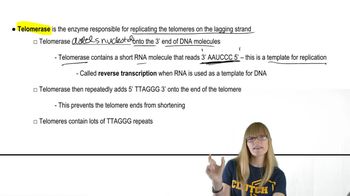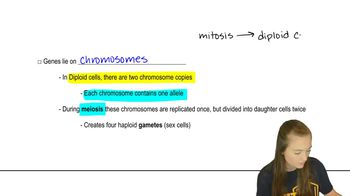Telomeres are found at the ends of eukaryotic chromosomes. How does telomerase assemble telomeres?
Table of contents
- 1. Introduction to Genetics51m
- 2. Mendel's Laws of Inheritance3h 37m
- 3. Extensions to Mendelian Inheritance2h 41m
- 4. Genetic Mapping and Linkage2h 28m
- 5. Genetics of Bacteria and Viruses1h 21m
- 6. Chromosomal Variation1h 48m
- 7. DNA and Chromosome Structure56m
- 8. DNA Replication1h 10m
- 9. Mitosis and Meiosis1h 34m
- 10. Transcription1h 0m
- 11. Translation58m
- 12. Gene Regulation in Prokaryotes1h 19m
- 13. Gene Regulation in Eukaryotes44m
- 14. Genetic Control of Development44m
- 15. Genomes and Genomics1h 50m
- 16. Transposable Elements47m
- 17. Mutation, Repair, and Recombination1h 6m
- 18. Molecular Genetic Tools19m
- 19. Cancer Genetics29m
- 20. Quantitative Genetics1h 26m
- 21. Population Genetics50m
- 22. Evolutionary Genetics29m
8. DNA Replication
Telomeres and Telomerase
Problem 38b
Textbook Question
Go to the OMIM website (https://www.ncbi.nlm.nih.gov/omim) and type 'dyskeratosis congenita autosomal dominant 1' (DKCA1) into the search bar. The result will include a clickable link to the disorder that has an OMIM number of 127550. Review the OMIM information you retrieve and notice that this disorder is caused by a mutation of a telomerase gene that results in abnormally rapid shortening of telomeres and the appearance of disease symptoms at progressively younger ages in successive generations of the affected families. Use this and other information on OMIM to assist with this problem. Go to reference number 15 at the bottom of the OMIM page for a link to a 2004 paper by Tom Vulliamy and colleagues that appeared in the journal Nature Genetics. Click on the 'Full text' option and download a copy of the paper. Look at Table 1 of the paper on page 448. This table lists the lengths of telomeres measured in members of the families in this study. Telomeres shorten with age, and the telomere lengths in Table 1 are age-adjusted. The negative numbers for telomere lengths in the table indicate that telomeres are shorter than average for age, and the more negative the number, the shorter the telomere. Based on Table 1, the the discussion in the Vulliamy et al. (2004) paper, and information available on OMIM, answer the following:
Why are telomeres of people with DKCA1 shorter than average?
 Verified step by step guidance
Verified step by step guidance1
Understand the role of telomeres: Telomeres are repetitive DNA sequences at the ends of chromosomes that protect them from degradation during cell division. Over time, telomeres naturally shorten with each cell division, but this process is regulated by the enzyme telomerase, which can replenish telomere length.
Identify the genetic cause of DKCA1: According to the OMIM entry for DKCA1 (OMIM #127550), this disorder is caused by mutations in the TERC gene, which encodes the RNA component of telomerase. These mutations impair the function of telomerase, leading to insufficient maintenance of telomere length.
Explain the impact of telomerase dysfunction: In individuals with DKCA1, the defective telomerase enzyme cannot effectively replenish telomeres. As a result, telomeres shorten more rapidly than normal during cell division, leading to shorter-than-average telomeres for their age.
Discuss the concept of genetic anticipation: The OMIM entry and the Vulliamy et al. (2004) paper highlight that DKCA1 exhibits genetic anticipation, where symptoms appear at progressively younger ages in successive generations. This is due to the inheritance of already shortened telomeres, which are further shortened in the next generation due to the defective telomerase.
Relate findings to Table 1 in the Vulliamy et al. paper: Table 1 shows age-adjusted telomere lengths for individuals with DKCA1. The negative values indicate that their telomeres are significantly shorter than average for their age. This data supports the conclusion that the mutation in the telomerase gene leads to accelerated telomere shortening, which underlies the symptoms of DKCA1.
 Verified video answer for a similar problem:
Verified video answer for a similar problem:This video solution was recommended by our tutors as helpful for the problem above
Video duration:
4mPlay a video:
Was this helpful?
Key Concepts
Here are the essential concepts you must grasp in order to answer the question correctly.
Telomeres
Telomeres are repetitive nucleotide sequences located at the ends of chromosomes, serving to protect them from deterioration or fusion with neighboring chromosomes. They shorten with each cell division, which is a normal part of aging. In individuals with dyskeratosis congenita autosomal dominant 1 (DKCA1), mutations in telomerase lead to accelerated telomere shortening, resulting in shorter telomeres than average for their age.
Recommended video:
Guided course

Telomeres and Telomerase
Telomerase
Telomerase is an enzyme that adds nucleotide sequences to the ends of telomeres, counteracting their natural shortening during cell division. In DKCA1, mutations in the telomerase gene impair its function, leading to insufficient telomere maintenance. This dysfunction results in the rapid shortening of telomeres, contributing to the early onset of disease symptoms in affected individuals.
Recommended video:
Guided course

Telomeres and Telomerase
Genetic Inheritance
Genetic inheritance refers to the transmission of genetic traits from parents to offspring. In the case of DKCA1, the disorder follows an autosomal dominant inheritance pattern, meaning that only one copy of the mutated gene from an affected parent can cause the disorder in the child. This pattern can lead to the appearance of symptoms at progressively younger ages in successive generations due to the cumulative effects of telomere shortening.
Recommended video:
Guided course

Diploid Genetics

 8:38m
8:38mWatch next
Master Telomeres and Telomerase with a bite sized video explanation from Kylia
Start learningRelated Videos
Related Practice
Textbook Question
412
views
